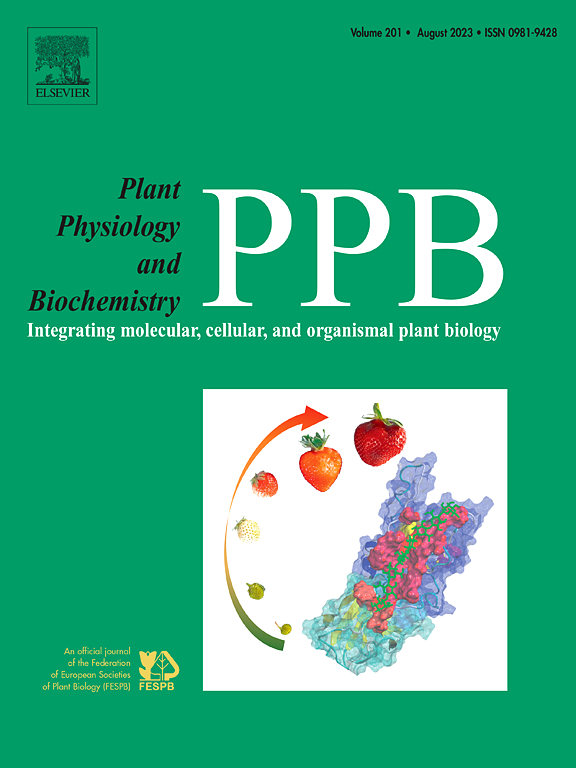Investigation into the mechanisms of photosynthetic regulation and adaptation under salt stress in lavender
IF 5.7
2区 生物学
Q1 PLANT SCIENCES
引用次数: 0
Abstract
Salinity stress is a major threat to agricultural productivity and sustainability, often causing irreversible damage to photosynthesis. Lavender, a valuable aromatic plant, experiences growth impacts under salt stress. However, the regulatory mechanisms of photosynthesis related to its adaptation to salt stress remain unclear. In this study, lavender was exposed to 0, 100, 200, and 300 mM NaCl for 28 days. It was observed that lavender effectively maintained chlorophyll stability when salt concentrations were below 200 mM and stress duration was under 21 days. The most effective model for lavender under salt stress was identified as a right-angled hyperbolic modified model. Under moderate salt stress (100 mM, 200 mM), genes such as LaPSB28, LaPSBS, and LaPSBR contributed to PSII core stability, enhanced photosynthetic pigment levels, and sustained high electron transfer rates to improve salt-tolerance. Additionally, LaLHCB4-1 and LaPSAK-1 regulated stomatal size, thereby facilitating gas exchange and supporting the photosynthetic process. Conversely, under high salt stress (300 mM), LaPSBW-1, -2, and LaPSAB were found to reduce photosynthetic pigment levels and inhibit photosynthetic activity. However, genes such as LaCHLG-2, LaGLG-3, LaBAM1-1 and -3, and LaCHLP-3 aided in starch synthesis by increasing pigment content, thus promoting energy balance and enhancing salt tolerance. This regulation involved photosynthesis-antenna proteins and pathways related to starch, sucrose, and chlorophyll metabolism. These findings may support the cultivation of salt-tolerant lavender varieties and maximize saline soil usage.
盐胁迫下薰衣草光合调节与适应机制的研究。
盐度胁迫是农业生产力和可持续性的主要威胁,经常对光合作用造成不可逆转的损害。薰衣草是一种珍贵的芳香植物,在盐胁迫下其生长受到影响。然而,其光合作用调控机制与适应盐胁迫的关系尚不清楚。在本研究中,薰衣草分别暴露于0、100、200和300 mM NaCl中28天。结果表明,当盐浓度低于200 mM、胁迫时间小于21 d时,薰衣草能有效保持叶绿素稳定性。确定了盐胁迫下薰衣草最有效的模型为直角双曲修正模型。在中等盐胁迫(100 mM、200 mM)条件下,LaPSB28、LaPSBS和LaPSBR等基因对PSII核稳定性、光合色素水平的提高和高电子传递率的维持有重要作用,从而提高了耐盐性。此外,LaLHCB4-1和lapsak1调节气孔大小,从而促进气体交换,支持光合过程。相反,在高盐胁迫(300 mM)下,LaPSBW-1、-2和LaPSAB降低了光合色素水平,抑制了光合活性。而lachlp -2、LaGLG-3、LaBAM1-1和-3以及LaCHLP-3等基因通过增加色素含量来辅助淀粉合成,从而促进能量平衡,增强耐盐性。这种调节涉及光合作用天线蛋白和与淀粉、蔗糖和叶绿素代谢相关的途径。这些发现可能为培育耐盐薰衣草品种和最大限度地利用盐碱地提供支持。
本文章由计算机程序翻译,如有差异,请以英文原文为准。
求助全文
约1分钟内获得全文
求助全文
来源期刊
CiteScore
11.10
自引率
3.10%
发文量
410
审稿时长
33 days
期刊介绍:
Plant Physiology and Biochemistry publishes original theoretical, experimental and technical contributions in the various fields of plant physiology (biochemistry, physiology, structure, genetics, plant-microbe interactions, etc.) at diverse levels of integration (molecular, subcellular, cellular, organ, whole plant, environmental). Opinions expressed in the journal are the sole responsibility of the authors and publication does not imply the editors'' agreement.
Manuscripts describing molecular-genetic and/or gene expression data that are not integrated with biochemical analysis and/or actual measurements of plant physiological processes are not suitable for PPB. Also "Omics" studies (transcriptomics, proteomics, metabolomics, etc.) reporting descriptive analysis without an element of functional validation assays, will not be considered. Similarly, applied agronomic or phytochemical studies that generate no new, fundamental insights in plant physiological and/or biochemical processes are not suitable for publication in PPB.
Plant Physiology and Biochemistry publishes several types of articles: Reviews, Papers and Short Papers. Articles for Reviews are either invited by the editor or proposed by the authors for the editor''s prior agreement. Reviews should not exceed 40 typewritten pages and Short Papers no more than approximately 8 typewritten pages. The fundamental character of Plant Physiology and Biochemistry remains that of a journal for original results.

 求助内容:
求助内容: 应助结果提醒方式:
应助结果提醒方式:


